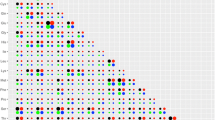Abstract.
Mitochondrial genetic codons can be categorized by four patterns of nucleotide-site degeneracy based on varying combinations of twofold- or nondegenerate sites at first codon positions and twofold- or fourfold-degenerate sites at third codon positions. Herein, a model of molecular evolution is introduced that uses these patterns to calculate expected substitution frequencies for each codon position and substitution type relative to overall number of synonymous or nonsynonymous substitutions. Regions of the pocket gopher cytochrome oxidase subunit I (COI) and cytochrome b (cyt-b) genes are analyzed using this model. Chi-square distributions are used to produce relative goodness-of-fit (GF) scores for measuring the difference between substitution frequencies predicted by the codon-degeneracy model (CDM), and frequencies inferred using a well-supported phylogenetic tree of closely related species. The GF scores for expected and observed synonymous (GFsyn= 0.429, p= 0.807) and nonsynonymous (GFns= 2.309, p= 0.679) substitution frequencies resulted in a failure to reject the CDM as a null hypothesis for the molecular evolution of COI and cyt-b in pocket gophers. Alternative tree topologies and calculations of transition bias for these data result in higher GF scores.
Similar content being viewed by others
Author information
Authors and Affiliations
Additional information
Received: 25 March 1999 / Accepted: 17 September 1999
Rights and permissions
About this article
Cite this article
McClellan, D. The Codon-Degeneracy Model of Molecular Evolution. J Mol Evol 50, 131–140 (2000). https://doi.org/10.1007/s002399910015
Issue Date:
DOI: https://doi.org/10.1007/s002399910015




